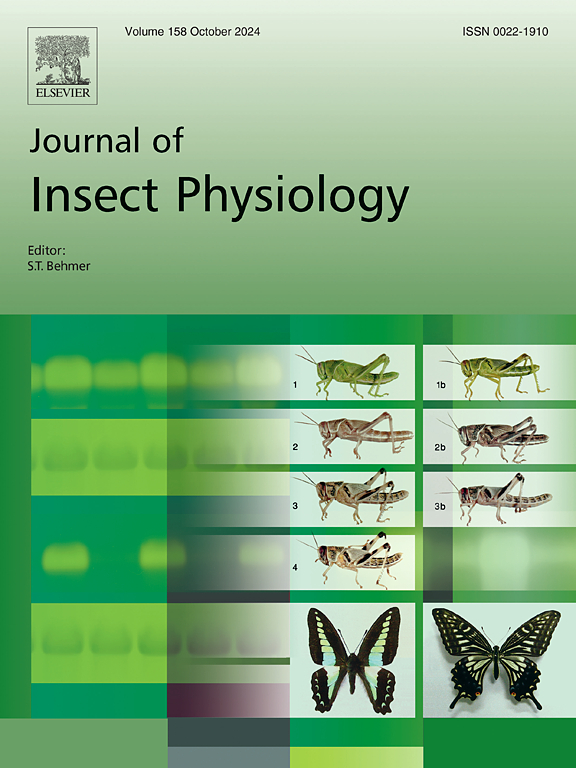Acetylcholine and Malpighian tubules of the kissing bug, Rhodnius prolixus: Evidence for expression of the non-neuronal cholinergic system and a diuretic action of acetylcholine
IF 2.3
2区 农林科学
Q1 ENTOMOLOGY
引用次数: 0
Abstract
Acetylcholine (ACh) and its signaling pathways are expressed in peripheral tissues in mammals, leading to the concept of a non-neuronal cholinergic signaling system. This non-neuronal ACh is now known to participate as an autocrine/paracrine in many processes, including transport of ions and water, immunity, and reproduction. Non-neuronal cholinergic signaling in insects has only recently been explored, with transcriptome analyses disclosing the presence of transcripts for pivotal components of the cholinergic system in non-neuronal tissues, including Malpighian tubules (MTs), ovaries, hemocytes, and fat body. A recent transcriptome analysis of MTs of the Chagas disease vector Rhodnius prolixus revealed the presence of transcripts for muscarinic ACh receptors and for acetylcholinesterase, raising the possibility that non-neuronal ACh may play a role in the control of MTs. Here we provide evidence for a non-neuronal ACh signaling pathway in MTs of R. prolixus. Transcripts for ACh signaling are expressed, and ACh is capable of stimulating small increases in secretion by isolated MTs (small, relative to the true diuretic neurohormones in R. prolixus). The effects of ACh are mimicked by carbachol and pilocarpine, with atropine inhibiting ACh- and pilocarpine-stimulated secretion. Blood gorging alters expression of transcripts for ACh signaling. We discuss the physiological relevance for ACh since MTs are much more than diuresis; they play major roles in immunity, detoxification, and in tolerance to overall stress. Perhaps ACh is a signaling component of these essential functions that might require an increase in secretion rate by MTs that is separate from the well described rapid post-prandial diuresis.

吻虫的乙酰胆碱和马尔比氏小管:非神经元胆碱能系统表达和乙酰胆碱利尿作用的证据。
乙酰胆碱(Ach)及其信号通路在哺乳动物的外周组织中表达,导致了非神经元胆碱能信号系统的概念。目前已知这种非神经元乙酰胆碱作为自分泌/旁分泌参与许多过程,包括离子和水的运输、免疫和生殖。昆虫的非神经元胆碱能信号直到最近才被探索,转录组分析揭示了非神经元组织中胆碱能系统关键成分的转录本的存在,包括马氏小管(MTs)、卵巢、血细胞和脂肪体。最近一项对南美锥虫病媒介长尾红鲑(Rhodnius prolixus) mt的转录组分析显示,存在毒蕈碱ACh受体和乙酰胆碱酯酶的转录本,这提高了非神经元乙酰胆碱酯酶可能在长尾红鲑mt的控制中发挥作用的可能性。乙酰胆碱信号的转录本得到表达,乙酰胆碱能够刺激分离的MTs分泌少量的增加(相对于长尾草中真正的利尿神经激素来说,这是少量的)。乙酰胆碱和匹罗卡品可以模拟乙酰胆碱的作用,阿托品抑制乙酰胆碱和匹罗卡品刺激的分泌。灌血改变乙酰胆碱信号转录物的表达。我们讨论ACh的生理相关性,因为mt不仅仅是利尿;它们在免疫、解毒和对整体应激的耐受中起着重要作用。也许乙酰胆碱是这些基本功能的一个信号组成部分,可能需要mt分泌速率的增加,这与我们所描述的餐后快速利尿是分开的。
本文章由计算机程序翻译,如有差异,请以英文原文为准。
求助全文
约1分钟内获得全文
求助全文
来源期刊

Journal of insect physiology
生物-昆虫学
CiteScore
4.50
自引率
4.50%
发文量
77
审稿时长
57 days
期刊介绍:
All aspects of insect physiology are published in this journal which will also accept papers on the physiology of other arthropods, if the referees consider the work to be of general interest. The coverage includes endocrinology (in relation to moulting, reproduction and metabolism), pheromones, neurobiology (cellular, integrative and developmental), physiological pharmacology, nutrition (food selection, digestion and absorption), homeostasis, excretion, reproduction and behaviour. Papers covering functional genomics and molecular approaches to physiological problems will also be included. Communications on structure and applied entomology can be published if the subject matter has an explicit bearing on the physiology of arthropods. Review articles and novel method papers are also welcomed.
 求助内容:
求助内容: 应助结果提醒方式:
应助结果提醒方式:


